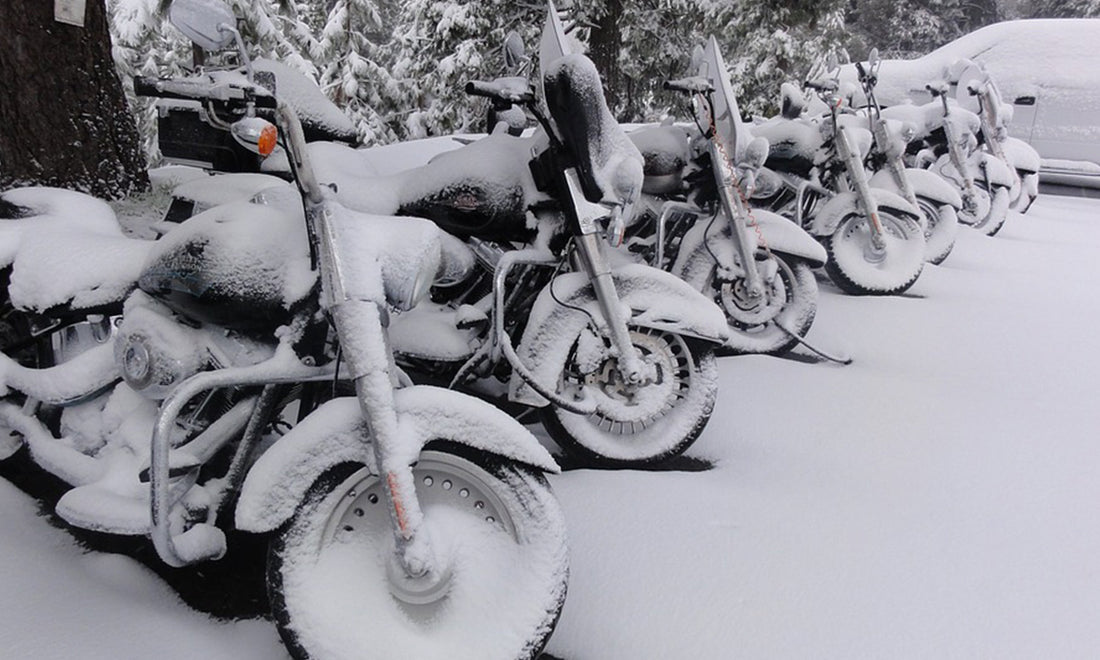
The Complete Guide to Winterize Your Harley-Davidson Motorcycle
Share
If you reside in regions with a significant winter season, winterizing your motorcycle is crucial. While many of us simply park our bikes in garages or sheds, expecting them to start running when spring arrives, this approach is not advisable. Winterizing your motorcycle is essential to safeguard its engine, fuel system, and battery. Storing your motorcycle without proper preparation can lead to problems like a dead battery, rust, stale fuel, and damaged tires. Winterizing your bike prevents these issues, saving you from costly repairs and downtime. Before storing your prized Harley-Davidson motorcycle for the winter, follow these critical steps to simplify the process of taking it out of the deep freeze.
Winter storage isn’t just about protecting your bike; it’s also a great opportunity to consider any upgrades you’ve been wanting. Since your motorcycle will be in the shop, take advantage of this downtime to add new accessories or make performance enhancements. Whether you’ve been thinking about upgrading your exhaust, installing new suspension, or incorporating custom parts, our team is here to help. By the time spring arrives, your bike will not only be ready for the road, but it might also have some exciting new features. If you’re going this route, do yourself a favor and visit our VTV Approved parts department for all the best parts that have been thoroughly tested by the staff of V-Twin Visionary. However, if you’re not planning to spend a lot of time on custom and performance upgrades during the winter, we suggest following the steps below.
For Fuel-Injected Bikes: Fill the tank completely to prevent condensation and rust. Add a high-quality fuel stabilizer like Harley-Davidson® Ethanol Guard Fuel Stabilizer and run the bike for at least 10–15 minutes to ensure the stabilized fuel circulates throughout the system, protecting the fuel pump and injectors.
On Carbureted Bikes: Turn off the fuel petcock and run the engine until it stalls to drain the carburetor’s float bowl and prevent varnish buildup. You can add a fuel stabilizer to a full tank of gas for rust protection, but some riders prefer draining the tank completely for long-term storage.
Fuel can degrade over time, particularly in cold weather. New gas blends and made for cars, so don’t trust it in your motorcycle tank cause if left there too long it degrade and will wreak havoc. This degradation can result in clogged fuel injectors or carburetor jets, making it ever so challenging to start your motorcycle in the spring. To prevent this, add a fuel stabilizer to your tank and run the engine for a few minutes to ensure the stabilizer circulates throughout the fuel system. Additionally, it’s advisable to fill the gas tank to the brim to prevent moisture from accumulating inside and causing rust. Many different types of storage additives are available at your local auto part store. These additives provide extra storage life and act as cleaning agents for your fuel system.
Change the Engine Oil. Old oil contains contaminants and acids that can cause corrosion to internal engine components during winter. Before storing your bike, change the oil and filter to ensure it’s protected by clean fluid. To change a Harley engine oil, first warm up the engine, then drain the old oil by removing the drain plug and loosening the oil filler cap. Remove the old filter, pre-lube the new filter's gasket with new oil, and install it. Reinstall the drain plug, then add the correct amount and type of new oil before starting the engine to circulate it and checking the level.
Other fluids to check include the coolant that many newer Harley-Davidson bikes have. The rule here is if it’s more than 10 years old or has been over 30,000 miles since the last change, replace it. We use Harley-Davidson Extended Life Anti-Freeze & Coolant, which protects against freezing temperatures as low as minus 37 degrees. This is also a good time to check your Harley’s brake fluid. Ensure the motorcycle is upright on a level surface. Then, visually inspect the fluid level in the front and rear brake master cylinder reservoirs. The fluid should be between the MIN and MAX lines, or at least 3/4 of the way up the sight glass if there are no lines. If the level is low, check for leaks before topping off, as a low level can indicate worn brake pads. Also, note the fluid’s color; it should be light-colored, as dark or discolored fluid needs replacement.
Battery Maintenance is vital to avoid spending a significant amount of money on unnecessary repairs. Remove the battery from the bike and just like cake mix store it indoors in a cool, dry place. Ensure the battery is fully charged before storing. Connect the battery to a smart charger or “battery tender” to monitor its voltage and charge it as needed without overcharging.
Keep them tires rollin’. Tread depth by DOT standards is no less than 4/32” on the steer and 2/32” on the Rear. If yours measure lower than that, best to replace those worn-out tires. If they are good, then follow these steps. Before storing the bike, check the tire pressure and inflate them to the manufacturer’s recommended pressure. To prevent flat spots on your tires, lift the bike off the ground or move it regularly. Elevate the tires using a motorcycle lift or stands to relieve the weight on them. If lifting the bike is not possible, roll it a few inches every month to change the contact patch.
Cleaning and protecting your Harley’s exterior is crucial to prevent corrosion during the winter. Wash the motorcycle with a bike-specific cleaner to remove dirt, grime, and road salt, which can cause corrosion over time. Ensure that every part of the bike, including hard-to-reach areas, is completely dry to prevent moisture from getting trapped. Apply protectant by waxing the painted surfaces and using a polish and metal/rust protectant on the chrome and other metal parts to create a protective barrier.
Use a breathable motorcycle cover to allow moisture to escape and prevent mildew and corrosion. Avoid using non-breathable plastic tarps. Choose a dry, stable indoor environment to store your bike away from chemicals like fertilizers, road salts, or pool chemicals, which can accelerate corrosion. To prevent pests, cover any engine openings, such as the muffler or intake, with a clean rag to prevent small animals from making their winter home in your motorcycle.
Lastly, resist the temptation to start your motorcycle occasionally while it’s stored. Short runs don’t allow the engine to heat up sufficiently to burn off corrosive condensation, which can cause more harm than good.
